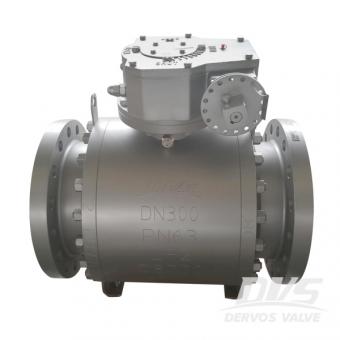
Trunnion mounted ball valve DN300 PN63 full bore Double Block and Bleed PMSS seal(metal seal+soft seal)blowout proof stem gearbox operation with LF2 body, LF2+ENP ball/seat and 410 stem. Quick Detail Type Ball Valve Size DN300 Design Pressure PN63 Construction DBB,Trunnion mounted ball valve ConnectionType Flange OperationType Gearbox Operated Body Material LF2 Ball Material LF2+ENP Stem Material 410 Seat Material LF2 +ENP Design Code API 6D Face to Face Dimension API 6D End Connection ASME B16.5 Pressure & Temp ASME B16.34 Medium Water, Oil and Gas Origin China
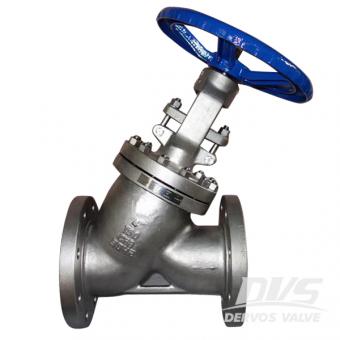
Y type globe valve. CF8 body/bonnet, F304 disc/stem, SS304+flexible graphite gasket and bronze bolt and nut. Plug type disc and Raised face flange connection. Quick Detail Type Globe Valve Size 4 inch DesignPressure CL150 Construction Y Type Globe Valve Connection Type Raised Face Flange Connection Operation Handwheel Design Code ASME B16.34 Face to Face ASME B16.10 Test & Inspection API 598 Body Material CF8 Temperature Range -29~538℃ Application WOG
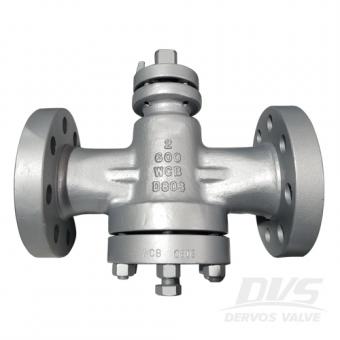
Inverted Pressure Balanced Lubricated Plug Valve is 2 inch and WCB body with metal seated. Apply to temperature lower than 80℃. Quick Detail Type Plug Valve Size 2” DesignPressure 150LB Construction Lubricated Type Plug Valve Connection Type Flange Connection Operation Lever/Wrench Design Code API6D Face to Face ASME B16.10 End Connection ASME B16.5 Pressure & Temp ASME B16.34 Test & Inspection API6D Body Material A216 WCB Temperature Range <80℃ Application WOG
The 8 inch Class 2500 gate valve is designed with pressure seal bonnet, butt weld connection, and gearbox operation. The 8 inch gate valve has carbon steel WCB body and trim 5. Quick Detail Type Gate Valve Size 8'' Design Pressure ANSI 2500 Construction Pressure Seal Bonnet, Flexible Wedge, Metal to Metal Seat ConnectionType Butt Weld (SW) OperationType Gearbox Operation Body Material A217 WC6 TrimMaterial Trim 5 Design Code API 600 Face to Face Dimension ASME B16.10 End Connection ASME B16.25 Pressure & Temp ASME B16.34 Medium Water, Oil and Gas Origin China Dimension & Material NPS DN Class 2 2 1/2 3 4 6 8 10 12 14 16 18 20 24 50 65 80 100 150 200 250 300 350 400 450 500 600 L(RF) 900LB 368 419 381 457 610 737 838 965 1029 1130 1500LB 368 419 470 546 705 832 991 1130 1257 1384 2500LB 451 508 578 673 917 1022 1270 L1(BW) 900LB 216 254 305 355 508 660 787 914 991 1092 1346 1473 1600 1500LB 216 254 305 406 559 711 864 991 1067 1194 1697 2500LB 279 330 368 457 610 762 914 1041 1118 1245 L2(RTJ) 900LB 371 422 384 460 613 740 841 968 1038 1140 1500LB 371 422 473 549 711 841 1000 1146 1276 1407 2500LB 454 514 584 683 927 1038 1292 H(Opne) 900LB 554 637 680 796 1084 1372 1494 1550 1960 2210 1500LB 554 637 767 875 1094 1372 1655 1834 2150 2260 2460 2721 2940 2500LB 610 654 753 850 1254 1374 1685 1894 2226 2382 2585 W 900LB 300 350 350 400 560 460* 610* 610* 610* 760* 1500LB 300 450 450 560 305* 460* 610* 610* 760* 760* 2500LB 500 500 600 600 460* 460* 610* Weight (RF) 900LB 50 84 92 154 341 622 950 1295 1720 2380 1500LB 60 91 128 182 394 795 1370 2120 2800 3870 2500LB 121 175 195 229 720 1295 2250 Weight (BW) 900LB 39 64 82 120 266 524 760 1090 1450 2018 1500LB 46 71 85 130 292 578 974 1615 2010 2815 3315 4150 5219 2500LB 88 135 144 158 500 892 1550 1978 2580 3780 5988 *Manual gear operator is recommended No. Part WCB WC6 WC9 C5 CF8 CF8M 1 Body A216 WCB A217 WC6 A217 WC9 A217 C5 A351 CF8 A351 CF8M 2 Seat A182 F6a A182 F22 A182 F22 A182 F5 A182 F304 A182 F316 3 Wedge A216 WCB A217 WC6 A217 WC9 A217 C5 A351 CF8 A351 CF8M 4 Stem A182 F6a SAEHNV3 A182 F304 A182 F316 5 Stuffing Box A216 WCB A217 WC6 A217 WC9 A217 C5 A351 CF8 A351 CF8M 6 Seal Ring ANSI 316L Flexible Graphite+316 7 Split Ring Steel F6 F6 F6 A182 F304 F316 8 Back Ring Steel Steel Steel Steel SS SS 9 Bolt A193 B7 A193 B7 A193 B7 A193 B7 A193 B8 A193 B8 10 Nut A194 2H A194 2H A194 2H A194 2H A194 Gr.8 A194 Gr.8 11 Yoke A216 WCB A217 WC6 A217 WC9 A217 C5 A351 CF8 A351 CF8M 12 Bolt A193 B7 A193 B7 A193 B7 A193 B7 A193 B8 A193 B8 13 Nut A194 2H A194 2H A194 2H A194 2H A194 Gr.8 A194 Gr.8 14 Packing Plate ANSI 410 ANSI 410 ANSI 410 ANSI 410 ANSI 304 ANSI 316 15 Packing Flexible Graphite(Braided and Ring) or PTFE 16 Split Pin Steel Steel Steel Steel Steel Steel 17 Eyebolt A193 B7 A193 B7 A193 B7 A193 B7 A193 B8 A193 B8 18 Gland A182 F6 A182 F6 A182 F6 A182 F6 A182 F304 A182 F316 19 Gland Flange A105 A105 A105 A105 A182 F304 A182 F316 20 Nut A194 2H A194 2H A194 2H A194 2H A194 Gr.8 A194 Gr.8 21 Stud A193 B7 A193 B7 A193 B7 A193 B7 A193 B7 A193 B7 22 Stem Nut Ni-resist A439-D2 23 Gear Box Purchased 24 Protector Steel 25 Nameplate ANSI 304 26 Rivet ANSI 304
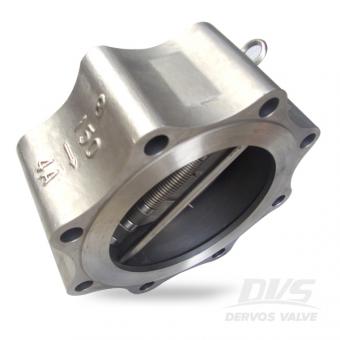
The 8 inch 150 LB dual disc non return check valve, designed per API 594, has dual plate and lug connection. The retainerless dual plate check valve is made of duplex stainless steel 4A as its body and trim material. Quick Detail Type Check Valve Size 8'' DesignPressure Class 150 Construction Dual Plate Type, Retainerless Connection Lug Type Design & Manufacture API 594 End to End ASME B16.10 Connection ASME B16.5 Pressure & Temp ASME B16.34 Test & Inspection API 598 Body Material Duplex Stainless Steel 4A Trim Material Duplex Stainless Steel Media W.O.G. Design Feature 1.Shor face to face dimension 2.Small in size with light weight 3.Swift close of disc with small water hammer 4.Vertically or horizontally installed 5.Smooth flow passway with small flow resistance 6.Long cycle life and high reliability

The 1 inch 800LB female threaded globe valve has plug disc, reduced port and manual handwheel operation. The valve is made of A105N body and trim 5 as per API 602. Quick Detail Type Globe Valve Size 1'' Pressure Class 800 Construction Bolted Bonnet, Reduced Port, Outside Scew & Yoke ConnectionType NPT Female Thread OperationType Handwheel Operated Design Code API 602 End to End Dimension ASME B16.10 Connection ASME B1.20.1 Pressure & Temp ASME B16.34 Test & Inspection API 598 Body Material Forged Steel A105 TrimMaterial 13CR+Stellite Temperature Range -29℃~+427℃ Application Water, Oil, Gas Origin China Product Range 1.Size up to 4 inch 2.Design pressure between 150LB to 2500LB 3.Connection: flange, socket weld, thread 4.Operation: handwheel, gearbox, bare stem, with actuators 5.Body material: carbon steel, stainless steel, alloy steel 6.Trim material: trim 1, 5, 8, 10, 12, 16 and ect. 7.Bolted bonnet, pressure sealed bonnet, welded bonnet, screwed bonnet 8.Reduced bore, full bore Inspection Reports Along with each order, Dervos will provide inspection reports and material test reports free of charge after shipment. All these certificates will let you have a clear picture of inspection process and results. Plus, these reports can be used for traceability.
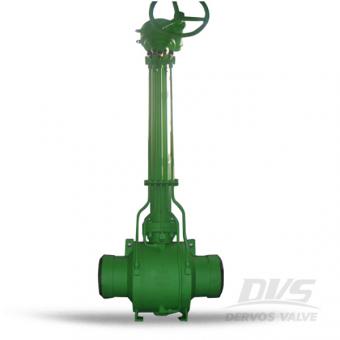
The Class 1500 4'' cryogenic ball valve is designed with extended stem for low temperature application. The valve is made of LF2 with fully welded body, butt weld end and gearbox operation. Design Feature -Fully welded & forged body -Extended stem or bonnet -Full port design and piggable -Anti blow-out stem -Antistatic function - Automatic cavity relief -Bi-directional seat and DBB design -With stem and seat grease fittings Quick Detail Type Ball Valve Size 4" Pressure ANSI 1500 Construction One-Piece Body, Fully Weld, Extended Stem or Bonnet, Full Port Connection Butt Weld Operation Gearbox Operated Body Material Low Temperature Steel A350 LF2 Design Code API 6D Pressure & Temp ASME B16.34 End to End Dimension ASME B16.10 End Connection ASME B16.25 Inspection API 598 Temperature Range -46℃~+200℃ Media Oil, Water, Gas Related Knowledge What is the difference between full bore and reduced bore ball valve? The internal diameter of a full bore ball valve is the same as the inner diameter of the pipe. The full bore ball valve has little resistance and pressure drop to the flow. Plus, the full bore ball valve is piggable. However, the internal diameter of a reduced port (standard port) ball valve is smaller than the inner pipe size. Flow restriction caused by the reduced port will cause a pressure drop. And sometimes a pig to clean the pipe will get stuck in the reduced port ball valve. Certificates Dervos could provide reports upon clients’ requests, such as ISO 9001, PED CE, EAC, API 607, API 6D, API 6A and etc.
The double offset high performance butterfly valve, with lever operation and lug body, is designed per API 609. The CF8M body and PTFE seat butterfly valve is more durable in serving the application. Quick Detail Type Butterfly Valve Size 3'' Design Pressure 150LB Construction Double Eccnetric, Soft Seat Connection Type Lug Operation Wrench Operated Design Code API 609 Face to Face ASMEB16.10 End Connection ASMEB16.5 Test & Inspection API 598 Body Material Stainless Steel CF8M Temperature Range -29℃~+150℃ Application Water, Oil, Gas Dimension Class 150 DN mm 40 50 65 80 100 125 150 200 250 300 350 400 NPS in 1 1/2 2 2 1/2 3 4 5 6 8 10 12 14 16 L mm 127 127 127 127 152 203.2 203.2 203.2 203.2 in 5 5 5 5 6 8 8 8 8 L1 mm 38.1 46 50.8 48 54 63.5 57 63.5 71.5 81 92 101.5 in 1.5 1.81 2 1.88 2.13 2.5 2.25 2.5 2.81 3.19 3.62 4 H mm 185 190 220 229 239 252 284 307 337 392 435 481 in 7328 7.48 8.7 9 9.4 9.9 11.2 12 13.3 15.4 17.1 19 D(W) mm 160 160 160 160 160 160 160 200 200 250 250 300 in 6.3 6.3 6.3 6.3 6.3 6.3 6.3 7.9 7.9 9.8 9.8 11.8 Weight (Kg) mm 12.5 13.5 17 38 72 105 148 182 230 in 8 9 10 10 11 14.5 34.2 66 98 134 168 200 Related Knowledge What is a high performance butterfly valve? A high performance butterfly valve is often designed with double offset and PTFE seat, to handle everything from general applications to viscous and corrosive liquids; corrosive gases and steam. Compared to concentric resilient seat butterfly valve, the disc of the high performance butterfly valve is arranged and positioned off the center of the pipe bore, which could reduce wear and tear to the valve during operation and increase sealing performance. In conlusion, high performance butterfly valve is applicable for higher pressure and temperature applications. Meanwhile, it has longer cycle life and better sealing ability.
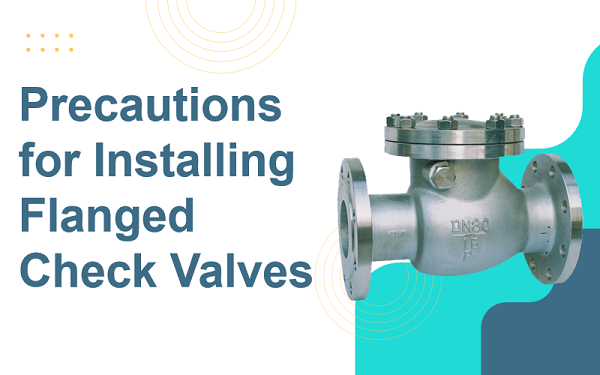
When installing flanged check valves, the following precautions should be taken to ensure their proper operation and long-term use: 1. Preparation before Installation Inspect the valve: Ensure that the valve has not been damaged during transportation and that there are no foreign objects inside the valve body. Clean the pipeline: Clean debris such as weld slag and rust from inside the pipeline to prevent them from entering the valve body. Verify parameters: Check the pressure, temperature, material, and other parameters on the valve's nameplate to ensure they meet the requirements of the working conditions. 2. Installation Position and Direction Flow direction marking: Ensure that the arrow marking on the valve is consistent with the flow direction of the medium in the pipeline. Vertical installation: Check valves are typically installed vertically, with the valve disc free to open and close. When installed horizontally, ensure that the valve disc can move freely. 3. Flange Connection Align flanges: Ensure that the flanges of the pipeline and valve are aligned to avoid offset or stress concentration. Flange gasket: Select the appropriate gasket material and place it correctly between the flanges to prevent leakage. Bolt tightening: Tighten the flange bolts uniformly in a diagonal sequence, gradually increasing the force to ensure uniform stress on the flange and prevent deformation. 4. Avoid Stress Pipeline support: Install appropriate supports before and after the valve to prevent the weight and stress of the pipeline from concentrating on the valve. Reduce vibration: In pipeline systems with significant vibration, take measures to reduce vibration transmission to the valve and extend its lifespan. 5. Testing and Commissioning Seal test: Conduct hydrostatic or pneumatic testing after installation to check the sealing performance of the flange connections and inside the valve. Function test: Confirm that the check valve can open and close normally during medium flow and stoppage. 6. Regular Maintenance Regular inspection: Regularly inspect the tightness and sealing performance of the flange connections to prevent loosening and leakage. Clean the valve body: Clean the inside of the valve body when necessary to prevent debris accumulation that could affect valve performance. Lubricate components: For check valves requiring lubrication, regularly inspect and add lubricant to ensure flexible valve disc movement. 7. Special Working Condition Considerations High temperature and pressure: In high-temperature and high-pressure conditions, select appropriate gasket and bolt materials to prevent leakage caused by thermal expansion and contraction or stress concentration. Corrosive media: For corrosive media, choose valves made of corrosion-resistant materials and implement corrosion prevention measures. 8. Environmental Requirements Protective measures: When installing in outdoor or corrosive environments, take protective measures for the valve, such as ap...
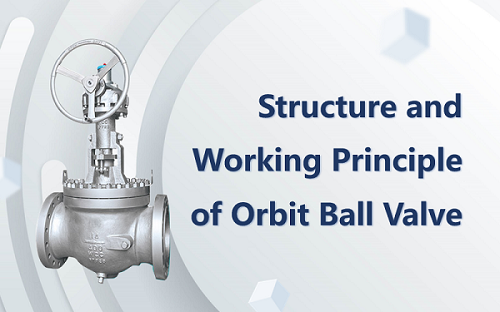
The Orbit Ball Valve, with its unique design and reliable performance, has been widely used in industrial fields such as oil, natural gas, and chemicals. 1. Structure of Orbit Ball Valve The structure design of the Orbit Ball Valve differs from that of a conventional ball valve. Its main components include: (1) Valve body: The body of the Orbit Ball Valve is typically made of forged or cast steel, offering high strength and corrosion resistance, and is capable of withstanding high-pressure and high-temperature environments. (2) Ball: The ball moves within the valve body through a specially designed track and is usually made of stainless steel or nickel-based alloys, providing excellent wear and corrosion resistance. (3) Seat: The seat is the part that comes into contact with the ball, typically made of metal to ensure sealing performance under high pressure and high temperature conditions. (4) Stem: The stem connects the ball to the actuator, responsible for transmitting operational torque to move the ball within the valve body. (5) Sealing System: This includes the seat seal and stem seal, ensuring no leakage of the medium. Seals are typically made of metal or high-performance polymer materials. (6) Actuator: This includes manual operation mechanisms or automated actuators used to control the opening and closing of the valve. 2. Working Principle of Orbit Ball Valve The working principle of an Orbit Ball Valve differs from that of a conventional ball valve, with its core function relying on the track movement and rotation of the ball within the valve body. The opening and closing process of an Orbit Ball Valve is as follows: Closed State: In the closed state, the sealing surface of the ball is tightly pressed against the valve seat, forming a reliable seal and preventing the flow of the medium. Opening Process: (1) Initial Eccentric Movement: When the actuator applies operational torque, the ball first moves eccentrically up or down along the track, gradually disengaging from the valve seat. This process reduces friction between the ball and the seat, preventing wear on the sealing surface. (2) Rotational Movement: After completing the eccentric movement, the ball continues to rotate 90 degrees, fully opening the passage and allowing the medium to flow smoothly through. As the ball's movement and rotation on the track occur in separate steps, the operation is smoother, and the required torque is lower. Closing Process: (1) Initial Rotational Movement: When the actuator operates in reverse, the ball first rotates 90 degrees to the closed position, thereby closing the passage. (2) Eccentric Movement: After the ball completes the rotation, it moves along the track back to the valve seat, forming a seal. This frictionless sealing process ensures high sealing performance and a long service life for the Orbit Ball Valve. 3. Advantages of Orbit Ball Valve (1) Frictionless Sealing: The eccentric and rotational movements of the Orbit Ball Valve are separ...
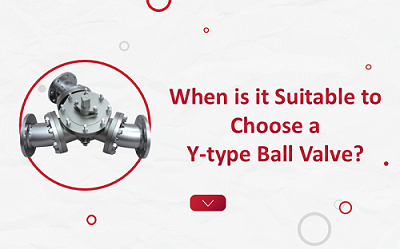
Y-type ball valves have gained popularity in industrial pipeline systems due to their unique Y-shaped structure and excellent fluid control performance. They are designed to reduce fluid resistance and improve flow efficiency, making them well-suited for specific applications. 1. Situations that require low flow resistance and high flow rates: ①High-flow pipeline systems: The Y-shaped design of the ball valve significantly reduces the resistance as fluid passes through the valve, making it suitable for pipelines that require high-flow control. This design ensures smooth and efficient fluid flow, reducing energy consumption. ②Applications with low pressure drop requirements: In systems sensitive to pressure drop, the low flow resistance characteristics of Y-type ball valves effectively reduce pressure losses in the system, ensuring overall pipeline efficiency. For example, in long-distance transportation pipelines and process flows that require specific pressure maintenance, Y-type ball valves are an ideal choice. 2. Handling high viscosity and media with particles: ①High-viscosity fluids: Y-type ball valves can handle high-viscosity fluids, avoiding excessive flow resistance within the valve. This makes them suitable for the transportation and control of high-viscosity media such as oils, syrups, and slurries. ②Media with particles: Due to their smooth and spacious flow passages, Y-type ball valves effectively prevent particle accumulation and blockages when handling fluids with particles. They are suitable for transporting media such as mud and wastewater. 3. Situations that require frequent operation and adjustment: ①High-frequency opening and closing operations: The design of Y-type ball valves allows them to perform well in frequent opening and closing operations, providing reliable sealing performance and long service life. In situations that require frequent operations, such as flow and direction control, Y-type ball valves are a reliable choice. ②Precise flow control: The flow passage design of Y-type ball valves enables precise flow control, making them suitable for process flows that require fine control of flow rates, such as chemical reactions and pharmaceutical production processes. 4. Installation environments with limited space: Y-type ball valves have a compact structure and occupy minimal space, making them suitable for installation in limited spaces. Whether it is inside equipment, dense pipeline areas, or systems that require high-density installation, Y-type ball valves can adapt flexibly. 5. Systems that require high fluid cleanliness: The design of Y-type ball valves ensures smooth flow passages that are not prone to impurity accumulation, making them easy to clean and maintain. In industries with high requirements for fluid cleanliness, such as pharmaceuticals, food, and beverages, Y-type ball valves are an ideal choice. 6. Cost control and ease of maintenance requirements: Due to their low flow resistance design, Y-type bal...
If you are interested in our products and want to know more details,please leave a message here,we will reply you as soon as we can.
"Everything is perfectly made. We are grateful for the confidence you are showing in our organization and fully trust our hard-work will be fruitful for both of our companies. You are truly a GEM for Dervos Valves. Our best compliments to you!"
"Your customer service is outstanding. ... ... The check valves works fine and the customer service certainly makes up for it. ... ... The customer service couldn’t be better."
"We are very satisfied with all your kind business supports. You are always kindly answering all our questions. So, we thank you for all your efforts. When we have any new project, we will readily make a contact with you!"
"I’ve received your document today. Thank you so much. Our engineer says your report seems to have been done quite well, he appreciated, of course we haven’t got the vannes so we haven’t had a check, but I believe there won’t be problem, hope so."
"Thank you for engaging with our organisation regarding Dervos. We place various orders with Dervos and products were always completed ex-factory, to drawing and within the time periods indicated. Dervos is a very proud company and place huge emphasis in delivering quality products to their customers."